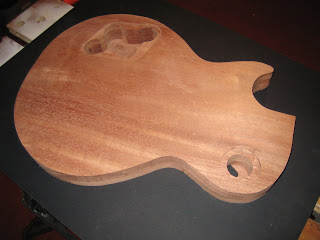
The first thing I start is the actual body. I'm using a piece of lovely grained Mahogany sourced over the internet from the USA. It is soundwood and has been kiln dried. Don't bother purchasing any other kind, with all the effort that goes in to making a guitar, it is wasted if it doesn't sound right when it is finished. Soundwood/tonewood is the only kind that will give you the correct end result.
The body blank /I bought is over-sized, so there is plenty of room to cut out the classic Les Paul shape in one go. When finished, the dimensions of the body are precisely 442mm long from neck are to the bottom end pin and 330mm wide. You need to be ordering a piece of wood that will fit this dimension in to it comfortably. My piece is also a little thicker than required, which also allows me to have the piece thickness sanded and leave a bit extra for final hand finishing.
WARNING: Do not buy a piece of wood and have it "planed" to the correct thickness. It MUST be sanded to thickness. I have to take mine to a specialist woodworking company for this job as I simply don't have the equipment. But for a few pounds, it's worth it. Planing a piece to thickness WILL rip the wood and make all kinds of unsightly marks in it. Possibly beyond recovery. Soundwood is way too dry for a planing machine and it rips it to pieces.
The body, before you begin, should be 45mm thick.
Using my plans as a template, I use a piece of tracing paper and carefully outline the back of the guitar shape for the body. I also mark the position of the cutaway for the switch and pot hole covers as well as the outline of the actual cavities. Then I cut these shapes out using a surgical scalpel. You can now tape the body template to the wood and mark the position for the apertures for the routing mentioned above as well as the outline of the body. This gives an accurate positioning for the work about to be carried out. The outline for the body is only for reference and positioning. A more accurate shape will be created to cut it to shape later. Mark all the shapes from your templates on the body in the correct position. Double check everything.
Again, using the same paper templates, you can make cutter guides for your router and be sure to mark them so you cut everything out the right way round.

If you are careful, you can use these templates over and over. I use double sided tape to stick them to the body and clamp them down whilst I am working. Here is the first template being used to cut the tone/volume pot cavity. For all the templates I make, I use MDF 20mm thick.

You should take time to do this and concentrate. With care, you can achieve perfect edges that are all neat and crisp. The pot cavity does NOT go all the way through as I have seen on many luthier sites when Les Pauls are being copied. It should stop 2mm short of reaching the other side. When you tap the front, it should sound like a drum.

Here's the pot cavity almost finished. Just a little skim of the bottom required and a short while tidying up rough edges. It is clear to see where I have lowered the router in steps to make my cuts.
Once finished, you can remove the template and replace it with the one to cut the cover recess. Again, use a paper template to make an MDF template and position it using the marks you made on the body from your plan paper templates.

Here you can see the cover recess finished in it's correct position in relation to the pencil guides on the body wood. And a nice close up to show the neatness using only the router.

And finally for this part of the work, check the cover fits. This is why it is important to mark cuts and then have the cover on hand to make sure the hole you are about to cut isn't too small or too large. It may be better to use the actual cover as a template to draw around than the plans if they differ.

Next job, again on the back of the guitar is to follow the exact same process to make the hole and recess for the switch. Remember, the more accurate you make your MDF templates, the better the actual cut will be. Here is the switch cavity done.
























































